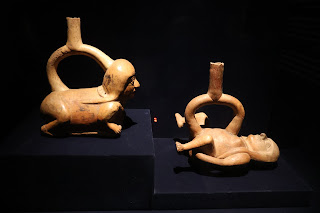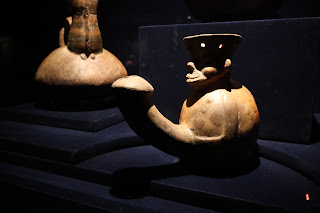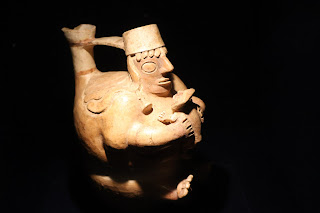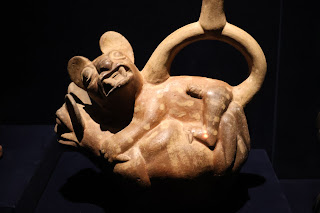The eroticism present in this major pottery collection evokes desire,
attraction and the coming together of the opposing yet complementary forces
that enable life to endlessly regenerate.
|
Entrance to the Erotic Gallery.
|
Room 1-2. Introduction
|
Salinar couple
Salinar culture, Formative Epoch (1250 BCE – 1 CE).
-
Pottery bottles depicting a pair of individuals, a man and a woman.
-
In one, we see a sexual act leading to insemination, and in the other
the act of masturbation, where the man embraces the woman as she
touches his penis.
-
The gestures and expressions of the protagonists seem to communicate a
sense of daring and complicity.
|
Room 3. Female and male body
|
Female connections
Moche culture, Florescent Epoch (1 CE – 800 CE).
-
Pottery bottles showing a woman in two positions often depicted in
sexual scenes.
-
In one of these, the woman is shown lying face down on her stomach,
her legs bent, as in other scenes depicting anal penetration. The
vessel’s handle connects the woman’s head with her coccyx, parts of
the body not associated with procreation.
-
In the other bottle, the woman is lying on her back, with her legs
open and raised, as in other scenes depicting vaginal sex. The handle
connects the woman’s heart and vagina, organs directly associated with
blood flow and procreation, thereby creating a circuit through which
liquid and air could flow through this ceremonial object.
|
|
Nasca female body
Nasca culture, Florescent Epoch (1 CE – 800 CE).
-
The artists of ancient Peru produced detailed representations of the
human body, demonstrating considerable knowledge of both female and
male anatomy.
-
In these Nasca pitchers, bottle and figurines, the female external
genitalia are emphasized, and also modeled or painted in exaggerated
proportions.
|
|
Female recipient
Moche culture, Florescent Epoch (1 CE – 800 CE).
-
In these pottery bowls the female form is shown with a
disproportionately large vulva, associating her power to give life
with the creative power of the earth: Pachamama, or Mother Earth.
These bowls have been modeled so that the vulva forms the entrance and
exit routes for liquids.
-
Symbolically, these bowls function as the vehicle for the flow of
liquids into the body, as when the female body is inseminated, and
also for the outward flow of fluids, as in childbirth.
-
The women depicted in the bowls are show as receptive bodies. When
liquid is poured into the bowls it disappears, seemingly absorbed by
the female body, leaving the bowl itself dry and the woman’s interior
moistened.
-
When a person drinks from this bowl, the action can be interpreted as
an act of oral sex performed upon the woman.
|
|
Salinar female body
Salinar culture, Formative Epoch (1250 BCE – 1 CE).
-
In the early art of the cultures of Peru’s northern coast, men and
women are depicted similarly, and in some cases they can only be
distinguished by their genitalia, when depicted nude.
-
These Salinar culture bottles show a female individual in a range of
positions, and in all cases her breasts and vulva are emphasized.
|
|
Drummer vulvas
Moche culture, Florescent Epoch (1 CE – 800 CE).
-
These sculptural pottery bottles are conceived in the form of a human
body, with the head representing the vulva, and the clitoris emerging
from between the labia.
-
These women are clothed in long dresses and adorned with typical
female jewelry in the form of a labret inserted below the lower lip.
-
Both individuals are playing the tinya, a small round drum
fashioned from leather. Its sound is like the heartbeat felt in a
mother’s uterus. The tinya is an instrument associated with the
subterranean world from which plants emerge.
|
|
Male genitalia
-
With their spouts or lips shaped like an erect penis, these pottery
bottles would have served to mimic the penis’s function as an emitter
of fluids, and they would probably have been used in rituals
associated with the fertilization of the earth.
-
When the user attempted to drink a liquid from the upper opening, it
would spill through the orifices located around the rim. And so, the
liquid contained in these vessels had to poured or drunk from the
penis.
|
|
Male body
Sculptural pottery bottles representing the erect penis.
-
In one of these, we see an anthropomorphized penis holding its nose
and entering the female body. In great detail, the Moche artist
depicts the vulva and the woman’s pubic hair surrounding the penis and
testicles.
-
The male body’s function as the emitter of semen is also associated
with power. Figures depicted with disproportionately large genitalia
are also shown with symbols of hierarchical status, such as decorated
attire and elite status throne-like seats.
|
|
Anthropomorphic penises
Moche culture, Florescent Epoch (1 CE – 800 CE).
-
In these sculptural pottery bottles male genitalia are depicted with
faces and human limbs.
-
The head of these figures is formed by the glans, and the knees by the
testicles.
|
|
Vicus sexual union
Vicús culture, Formative Epoch (1250 BCE – 1 CE).
-
These sculptural clay whistling bottles depict couples engaged in two
different types of sexual union.
-
In one, with his penis erect the man mounts the woman, who is lying on
her back. The man holds a child in his arms.
-
In the other, anal penetration is depicted. The woman is wearing face
and body paint, her braided hair is twisted into buns, and she is
supporting herself on her four limbs. The man is wearing a
three-pointed headdress and breastplate, face and body paint, and ear
adornments, indicating his high status.
|
|
Viru sexual union
Viru culture, Formative Epoch (1250 BCE – 1 CE).
-
These sculptural bottles depict a couple engaged in two different
types of sexual union. One is a scene of vaginal intercourse, while
the other depicts anal penetration.
-
The two vessels appear to depict the same couple, with the man shown
wearing face paint and cross-like symbols on his headdress.
|
Room 4. Life-giving sexual union
|
Moche sexual union
Moche culture, Florescent Epoch (1 CE – 800 CE).
-
These sculptural clay bottles depict couples with attributes
indicating their high social rank, engaged in two types of sexual
activity.
-
In one of these scenes, procreative sexual union is depicted. The
woman is lying on her back with her legs open. She is wearing face
paint, a breastplate with a checkerboard pattern, and wristbands. The
man is wearing a cap with a small mantilla, usually worn by Moche
priests, and he is holding the woman by the legs.
-
In the other piece, anal penetration is depicted. The woman is wearing
face paint. Her vulva is visible and she is supporting herself on all
four limbs. The man is wearing a cap with circular motifs and face
paint. His tongue is extended and his penis is disproportionately
large.
|
|
Reproduction
These sculptural pottery bottles depict scenes of intercourse between a
man and a woman. The man is wearing a turban, tunic and loincloth.
-
In one scene, the woman wears braids, round ear adornments and a
breastplate, and she is lying on her back.
-
In the other the man is holding the woman by the back of her head and
kissing her chin as she embraces him.
|
|
Active woman
Moche culture, Florescent Epoch (1 CE – 800 CE).
-
In these scenes of sexual union, the woman is shown on top of the man,
in a more active role.
-
The handle connects the woman’s body with the main body of the bottle,
creating a circuit through which water could flow, while the spout
connects the interior and exterior of the vessel.
|
|
Breastfeeding
-
Breastfeeding is a manifestation of a woman’s ability to nurture. In
the art of ancient Peru, many works depict women breastfeeding, with
the infant holding the mother while being fed.
-
In one of these pieces, identifiable by his serpent ear adornments,
the mythological Moche hero Ai Apaec is being breastfed as an infant
by a “cacao mother”. To this day in Peru, the properties of the cacao
husk are known for their ability to increase the production of
breastmilk, and its consumption is encouraged.
-
Scenes depicting divine mothers breastfeeding their children are found
in many cultures. Christian art also inherited this tradition. Mary,
while not herself acknowledged as divine, assumes the presence and
significance of all the goddesses who preceded her: Egypt’s Isis,
Sumer’s Inanna, Greece’s Aphrodite, and Rome’s Cybele. Like those
earlier figures, she gives birth to and nurtures a semi-divine being
who dies only to be reborn.
|
|
Nasca couple
Nasca culture, Florescent Epoch (1 CE – 800 CE).
-
The original sexual union between the ancestors is depicted in clay
vessels across different pottery styles found in southern and northern
Peru, both on the coast and in the highlands.
-
The arrangement of this scene is very similar in all cases, and in
most examples the details emphasize the man’s headdress and the
woman’s body decoration.
-
In these pieces, the woman is wearing wristbands and body paint. The
man is wearing a turban and wristbands.
|
|
Union between a toad and jaguar
Moche culture, Florescent Epoch (1 CE – 800 CE).
-
In the Andean worldview, toads are associated with the humid world,
while jaguars are associated with the earth.
-
The two animals are depicted in mythological union. The jaguar adopts
the dominant male posture, while the toad takes a passive female role.
From this union a toad with the ears of a jaguar is born, and from its
body there sprout cassava plants.
|
|
Intercourse among animals
Moche culture, Florescent Epoch (1 CE – 800 CE).
-
Just as the gods engage in sexual union to give origin to life, in the
earthly world humans and animals engage in intercourse to procreate
and perpetuate the cycle of life.
- Here we see the coupling of llamas, deer, monkeys and mice.
|
|
Bed-sharing
Moche culture, Florescent Epoch (1 CE – 800 CE).
-
In these sculptural clay bottles, the ancestral practice of
bed-sharing is depicted, in which infants sleep with their parents.
The couple is shown engaging in intercourse while the mother
breastfeeds the child.
-
In most such scenes, anal penetration is depicted. This
non-reproductive sexual practice may be associated with the temporary
postpartum infertility linked to breastfeeding.
|
|
Couple under a blanket
Moche culture, Florescent Epoch (1 CE – 800 CE).
-
In these sculptural clay bottles, a couple is shown copulating,
partially covered by a blanket so that only their heads and genitals
can be seen.
-
The way in which the blanket is depicted recalls a field system
divided into smallholdings, marked with cross-like motifs, the
universal symbol of encounter and connection.
|
|
Non-reproductive sex
-
In these scenes featuring anal penetration, lying face down the
woman’s role is less active. In some cases, she is depicted as larger
than the man, in what may be an allusion to her rank. Here we see the
men wearing turbans and the women adorned with necklaces and face
paint, indicating their high social status.
-
The association of this non-reproductive sexual practice with the
underworld is expressed in the participation of individuals with
mutilated faces, possibly intended to represent the dead.
-
The pottery makers of ancient Peru incorporated the scene depicting
the man penetrating the woman into the main body of the vessel and the
positions of the handle and spout. In most cases, it appears that the
artist intended to connect the act of penetration with the flow of
liquid within the vessel.
|
|
Pregnancy and childbirth
Moche culture, Florescent Epoch (1 CE – 800 CE).
-
Childbirth marks the transition from the dark, watery interior of the
mother’s uterus, deep within the female body, to the exterior world.
-
In one of these pieces, we see a woman giving birth, accompanied by
two midwives: a doula (a woman who assists another woman during
pregnancy) and the birth attendant who delivers the child.
-
The woman giving birth is depicted with the dark pigment of the
secondary areola around her nipples, a sign that her body is preparing
itself for breastfeeding.
|
|
Recuay couple
Recuay culture, Florescent Epoch (1 CE – 800 CE).
-
The original sexual union of the ancestors is depicted in clay vessels
across different pottery styles found in southern and northern Peru,
both on the coast and in the highlands.
-
The arrangement of this scene is very similar in all cases, and in
most examples the details emphasize the man’s headdress and the
woman’s body decoration.
-
In these pieces, the man is wearing a frontal plumed headdress, round
ear adornments with circular motifs, and a breastplate with geometric
circular designs. The woman is wearing a scarf and face paint.
|
|
Scenes of fellatio
-
In these scenes depicting fellatio, the men are shown wearing a small
mantilla and cap, items associated with priests. The women are also
adorned, indicating their high social status.
-
In one of these pieces, an older man is depicted with a wrinkled face,
possibly with the intention of emphasizing the ability of men to
continue producing semen into old age, even as the moment approaches
for their transition to the underworld.
-
In several such scenes, the women are depicted as larger than the men,
possibly as an allusion to their importance as givers of life,
symbolically representing Pachamama, who receives fertilizing water
during rituals.
|
|
Sexual stimulation of a mythological woman
Moche culture, Florescent Epoch (1 CE – 800 CE).
-
In this clay pitcher a scene of female masturbation is depicted. A
male figure with cadaverous features, extremely thin limbs and a
broken head sexually stimulates the woman.
-
The nature of her adornments, including a bead necklace, and the way
her hair is braided into two plaits, indicate that the woman depicted
in this scene is a mythological figure.
|
Room 5. Sexual activity in the underworld
|
Fellatio as a ritual offering
Chancay culture, Imperial Epoch (1300 CE – 1532 CE).
-
In ancient Peru, scenes depicting fellatio are associated with ritual
offerings intended to propitiate the fertility of the earth.
-
This pair of articulated wooden dolls represent a man and woman, both
wearing face paint. They are engaged in an act of fellatio.
|
|
The underworld and the reversal of order
Moche culture, Florescent Epoch (1 CE – 800 CE).
-
When the dead awaken and ascend to the earthly world (Kay Pacha), and
the deity passes from the celestial world (Hanan Pacha) to the
underworld (Uku Pacha), anal penetration is practiced, in response to
this reversal of order.
-
The dead rise from their tombs, play music, dance, and assist the
deity in crossing from the earthly world to the underworld, pushing
his head and pulling his feet.
|
|
Scenes of masturbation
Moche culture, Florescent Epoch (1 CE – 800 CE).
-
In one of these pieces, a cadaverous man, an inhabitant of the
underworld, is being masturbated by a woman. This occurs in the world
of the dead, as indicated by the step symbol on one of the walls of
the vessel, and by the painted ceremonial vessels, which are funerary
offerings. Painted next to the couple, we see a bowl with a handle,
used for toasting corn and known as a “canchero”.
-
These cancheros are ceremonial vessels, probably used in propitiation
rites to receive real or symbolic semen. In these vessels, the woman
is shown as the recipient, and the orifice through which the liquid
enters is her vagina.
|
|
Elite ancestors
Moche culture, Florescent Epoch (1 CE – 800 CE).
-
The characteristics of their headdress or crown identify the
cadaverous figures in these scenes as elite ancestors who, in the
world of the dead, retain the high social status they enjoyed in life.
-
The ancestor is flanked by smaller men and women, some of whom are
depicted as cadaverous, while others are not.
|
|
Music in the world of the ancestors
Moche culture, Florescent Epoch (1 CE – 800 CE).
-
In these sculptural clay bottles, cadaverous male figures wear
headdresses and decorative tunics, and in some cases large ear
adornments, indicating their high social status.
-
These figures are shown playing an instrument. Most of them are
playing panpipes, an instrument played in pairs, the complementary
sounds of which propitiate contact between the earthly world (Kay
Pacha) and the world of the dead (Uku Pacha).
|
|
Propitiation of the ancestors
Moche culture, Florescent Epoch (1 CE – 800 CE).
-
The inhabitants of the underworld participate in a range of sexual
acts, involving particularly the touching of the genitals, kissing,
and fellatio.
-
They are aroused in order to demonstrate their potency and to emit
fertilizing fluid. They are also shown arousing the woman who
represents Mother Earth.
|
|
Music and dance in the underworld
Moche culture, Florescent Epoch (1 CE – 800 CE).
-
In Moche art, scenes featuring activities in the underworld, as in the
case of these vessels, tend to be depicted in relief.
-
The band where the inhabitants of the underworld are shown is located
in the middle of the vessel, surrounding it completely, as if a layer
of clay had been removed from the surface of the vessel to reveal what
is going on inside. In this way, the interior of the vessel mimics the
underworld, where the dead dwell.
|
|
Music and dance in the underworld
Moche culture, Florescent Epoch (1 CE – 800 CE).
-
In Moche art, scenes featuring activities in the underworld, as in the
case of these vessels, tend to be depicted in relief.
-
The dead are depicted dancing hand-in-hand or with their arms linked,
and playing instruments such as flutes, or pinkullos, and drums, or
tinyas. In these dances, the male skeletons are usually shown with an
erect penis, indicating that these inhabitants of the underworld
remained potent and vital.
|
|
Ancestral sexual union
Moche culture, Florescent Epoch (1 CE – 800 CE).
-
In the art of ancient Peru, an episode from Moche mythology, depicted
in relief on clay bottles and pitchers, offers us in visual detail the
moment when the cycle of life is regenerated.
-
Following his death and passage into the underworld, the hero Ai Apaec
is finally joined with Mother Earth. Pachamama receives him and they
copulate, accompanied by individuals who “water” the encounter, in
order to ensure the growth of the fruit of their union.
|
|
Scenes of fellatio
Moche culture, Florescent Epoch (1 CE – 800 CE).
-
In this scene depicting ritual fellatio, the woman exhibits the
features that characterize the archetypal female represented by
Pachamama, or Mother Earth, and she is modeled on a larger scale than
the man in the scene. Her hair is braided and she is wearing tubular
ear adornments, a breastplate, wristbands, and a tunic with geometric
designs. She is kneeling before the man, who is wearing the type of
turban associated with priests, a breastplate, tunic and loincloth.
-
The head of this woman who receives the seminal fluid that will be
offered to the earth was depicted in “cancheros”, the clay vessels
used to toast corn. The opening of this vessel is formed by the
woman’s mouth.
|
|
The embrace of Ai Apaec
Moche culture, Florescent Epoch (1 CE – 800 CE).
-
This sculptural pitcher depicts the mythological Moche hero Ai Apaec,
recognizable by his serpent-headed belt and ear adornments, and his
feline fangs, embracing and at the same time clutching the hair of an
individual with the appearance of a prisoner, with his plumed
headdress, tunic, belt and bag on his back.
-
The piece has been modeled in the form of a tuber, probably as an
allusion to the sacrifice that occurs in the underworld, the world of
the ancestors. The prisoner symbolizes the offering of life made by
the hero to the earth.
-
In order to ensure the continuity of the cycle of life, two events
were considered necessary: the union of a fertilizing male deity with
Mother Earth, and an offering of sacrificial blood that would enable
the renewal of life’s essential cycle, as occurs in nature.
|
|
The dead fertilizing the underworld
Moche culture, Florescent Epoch (1 CE – 800 CE).
-
The central piece, a sculptural clay vase, depicts a cadaverous male
individual, a sexually active inhabitant of the underworld. His penis
is shown as disproportionately large, emphasizing his ability to
produce semen and, therefore, to fertilize.
-
The other sculptural clay bottles depict the inhabitants of the
underworld, whom we would consider the dead. However, in the Andean
worldview, they remain vital and active in the world below.
-
Their vitality is manifested in their ability to continue fertilizing,
as can be seen in these bottles, where cadaverous men masturbate to
produce fertilizing semen.
|
|
Propitiation of the ancestors
Moche culture, Florescent Epoch (1 CE – 800 CE).
-
The male and female inhabitants of the underworld participate in a
range of sexual activities, including mutual masturbation and kissing.
-
They are aroused in order to demonstrate their potency and to emit the
semen which symbolically fertilizes the earth from the underworld.
Here a woman is also shown being stimulated by her male partner.
|
|
Recuay ancestors
Recuay culture, Florescent Epoch (1 CE – 800 CE).
-
The paccha is a ceremonial vessel associated with the worship
of water and fertility in ancient Peru.
-
In this clay paccha, a lavishly attired male Recuay deity is
depicted, copulating with a woman whose body is fused with the vessel
itself. Four priestesses surround the scene.
|
Room 6. Regeneration
|
Sexual union between Ai Apaec and Pachamama
Moche culture, Florescent Epoch (1 CE – 800 CE).
-
In the world of the ancestors, Mother Earth is inseminated by male
power, symbolized in the form of the mythological hero Ai Apaec, who
displays his feline fangs and wears a serpent belt. For her part, the
archetypal woman who represents Mother Earth wears a tunic and styles
her hair in braids.
-
This ancestral union occurs in order to ensure the rebirth of the sun,
and the renewal of the life of the community.
-
In this scene, reproductive sexual union between men and women in this
world is presaged by the original ancestral union.
|
|
Regeneration
Moche culture, Florescent Epoch (1 CE – 800 CE).
- Sexual union between Ai Apaec and Pachamama.
-
Tree of life with ceremonial and medicinal ulluchu and Nectandra
fruits, and harvesting monkeys.
- Ulluchu fruits.
- Harvesting monkeys.
- Two-headed serpent representing the celestial vault.
- Tomb protected by inhabitants of the underworld.
- Tomb guardian with a mutilated foot.
- Llama used as a pack animal.
- Wave motifs.
- Woman holding a child.
- Figure with a double-plumed headdress, carrying a bag.
- Bowl offering.
|
See also
Sources
Location
Larco Museum - Cultures of Ancient Peru
Larco Museum - Sacrifice Ceremony
Larco Museum - Ceremonial Vessels
Larco Museum - Ritual Warfare and Music
Larco Museum - Visible Storage
Larco Museum - Café Restaurant












































































































































































